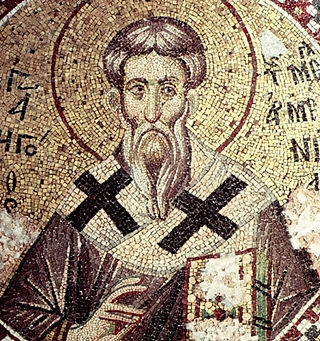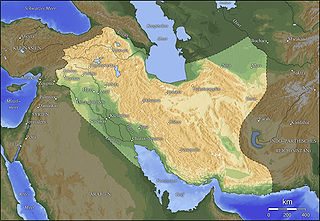
Diocletian, nicknamed Jovius, was Roman emperor from 284 until his abdication in 305. He was born Diocles to a family of low status in the Roman province of Dalmatia. Diocles rose through the ranks of the military early in his career, eventually becoming a cavalry commander for the army of Emperor Carus. After the deaths of Carus and his son Numerian on a campaign in Persia, Diocles was proclaimed emperor by the troops, taking the name Diocletianus. The title was also claimed by Carus's surviving son, Carinus, but Diocletian defeated him in the Battle of the Margus.
The 300s decade ran from January 1, 300, to December 31, 309.
The 310s decade ran from January 1, 310, to December 31, 319.

Year 313 (CCCXIII) was a common year starting on Thursday of the Julian calendar. At the time, it was known as the Year of the Consulship of Constantinus and Licinianus. The denomination 313 for this year has been used since the early medieval period, when the Anno Domini calendar era became the prevalent method in Europe for naming years. This year is notable for ending of the persecution of Christians in the Roman Empire.
Year 305 (CCCV) was a common year starting on Monday of the Julian calendar. At the time, it was known as the Year of the Consulship of Constantius and Valerius. The denomination 305 for this year has been used since the early medieval period, when the Anno Domini calendar era became the prevalent method in Europe for naming years.
The 290s decade ran from January 1, 290, to December 31, 299.
The 280's decade ran from January 1, 280, to December 31, 289.

Year 300 (CCC) was a leap year starting on Monday of the Julian calendar. At the time, it was known as the Year of the Consulship of Constantius and Valerius. The denomination 300 for this year has been used since the early medieval period, when the Anno Domini calendar era became the prevalent method in Europe for naming years.

Year 299 (CCXCIX) was a common year starting on Sunday of the Julian calendar. In the Roman Empire, it was known as the Year of the Consulship of Diocletian and Maximian. The denomination 299 for this year has been used since the early medieval period, when the Anno Domini calendar era became the prevalent method in Europe for naming years.

Year 301 (CCCI) was a common year starting on Wednesday of the Julian calendar. At the time, it was known as the Year of the Consulship of Postumius and Nepotianus. The denomination 301 for this year has been used since the early medieval period, when the Anno Domini calendar era became the prevalent method in Europe for naming years.

Year 302 (CCCII) was a common year starting on Thursday of the Julian calendar. At the time, it was known as the Year of the Consulship of Constantius and Valerius or, less frequently, year 1055 Ab urbe condita. The denomination 302 for this year has been used since the early medieval period, when the Anno Domini calendar era became the prevalent method in Europe for naming years.

Year 296 (CCXCVI) was a leap year starting on Wednesday of the Julian calendar. In the Roman Empire, it was known as the Year of the Consulship of Diocletian and Constantius. The denomination 296 for this year has been used since the early medieval period, when the Anno Domini calendar era became the prevalent method in Europe for naming years.

Year 293 (CCXCIII) was a common year starting on Sunday of the Julian calendar. In the Roman Empire, it was known as the Year of the Consulship of Diocletian and Maximian. The denomination 293 for this year has been used since the early medieval period, when the Anno Domini calendar era became the prevalent method in Europe for naming years.

Year 306 (CCCVI) was a common year starting on Tuesday of the Julian calendar. At the time, it was known as the Year of the Consulship of Constantius and Valerius. The denomination 306 for this year has been used since the early medieval period, when the Anno Domini calendar era became the prevalent method in Europe for naming years.


Year 311 (CCCXI) was a common year starting on Monday of the Julian calendar. At the time, it was known as the Year of the Consulship of Valerius and Maximinus. The denomination 311 for this year has been used since the early medieval period, when the Anno Domini calendar era became the prevalent method in Europe for naming years.

Galerius Valerius Maximianus was Roman emperor from 305 to 311. During his reign he campaigned, aided by Diocletian, against the Sasanian Empire, sacking their capital Ctesiphon in 299. He also campaigned across the Danube against the Carpi, defeating them in 297 and 300. Although he was a staunch opponent of Christianity, Galerius ended the Diocletianic Persecution when he issued the Edict of Toleration in Serdica (Sofia) in 311.

Narseh was the seventh Sasanian King of Kings of Iran from 293 to 303.

The Battle of Satala was fought in 298, in Armenia, between the forces of the Roman Empire under the Tetrarch Galerius and the forces of the Sasanian Empire of Persia led by Shah Narseh (Narses). The battle was an overwhelming victory for the Roman army, with the Persian army destroyed as a fighting force. The Romans obtained an enormous amount of plunder from the defeated Persians, and captured Narseh's principal wife. The campaign concluded with a very favourable peace treaty for Rome, with Persia ceding considerable territory.

The Battle of Carrhae, also known as the Battle of Callinicum, took place in 296 or 297, after the invasion of Mesopotamia and Armenia by the Sasanian king Narseh. The battle took place between Carrhae (Harran) and Callinicum (al-Raqqah) and was a victory for the Sasanians. Narseh attacked with forces recruited from the Euphrates frontier. He managed to defeat his opponent by good timing.














